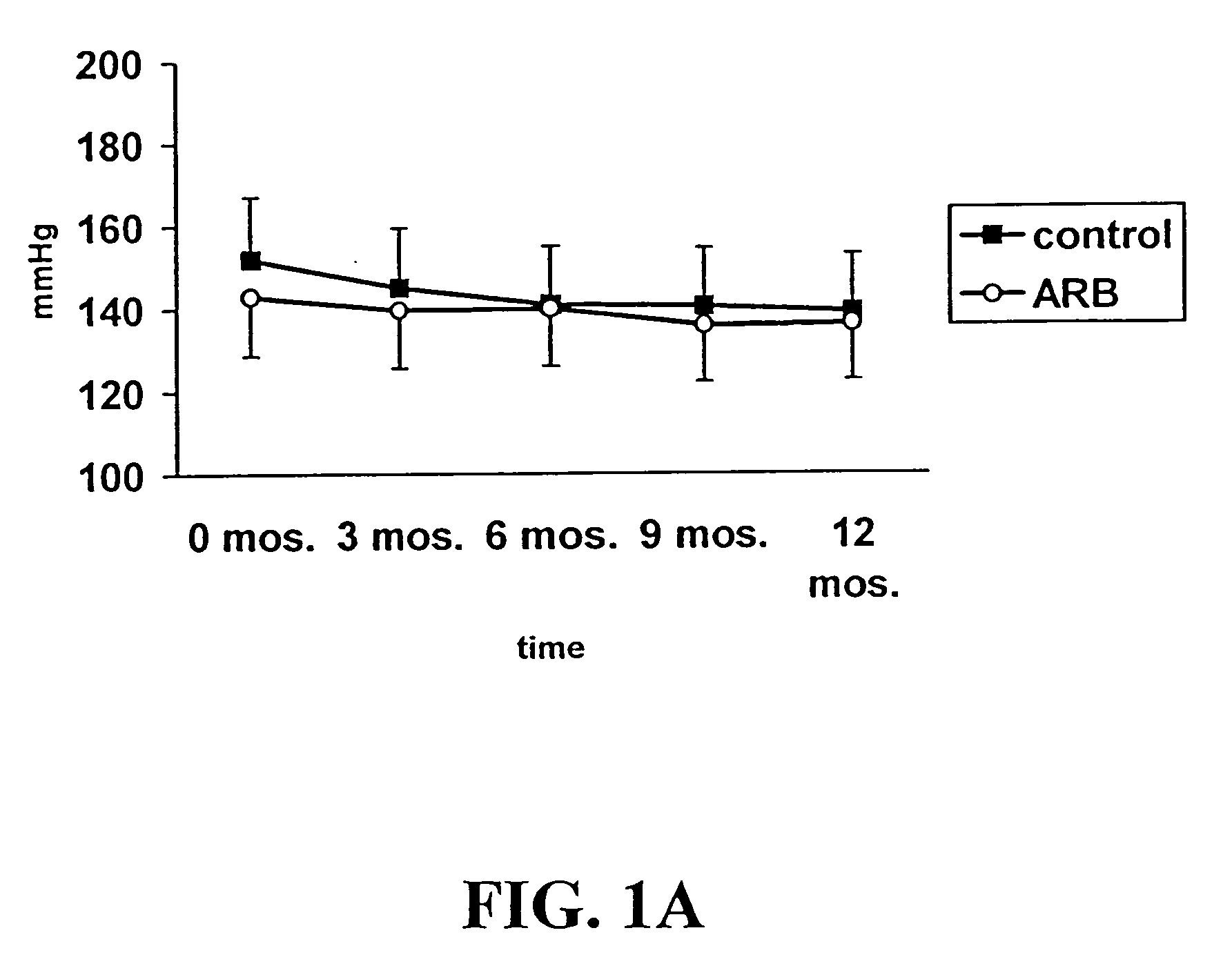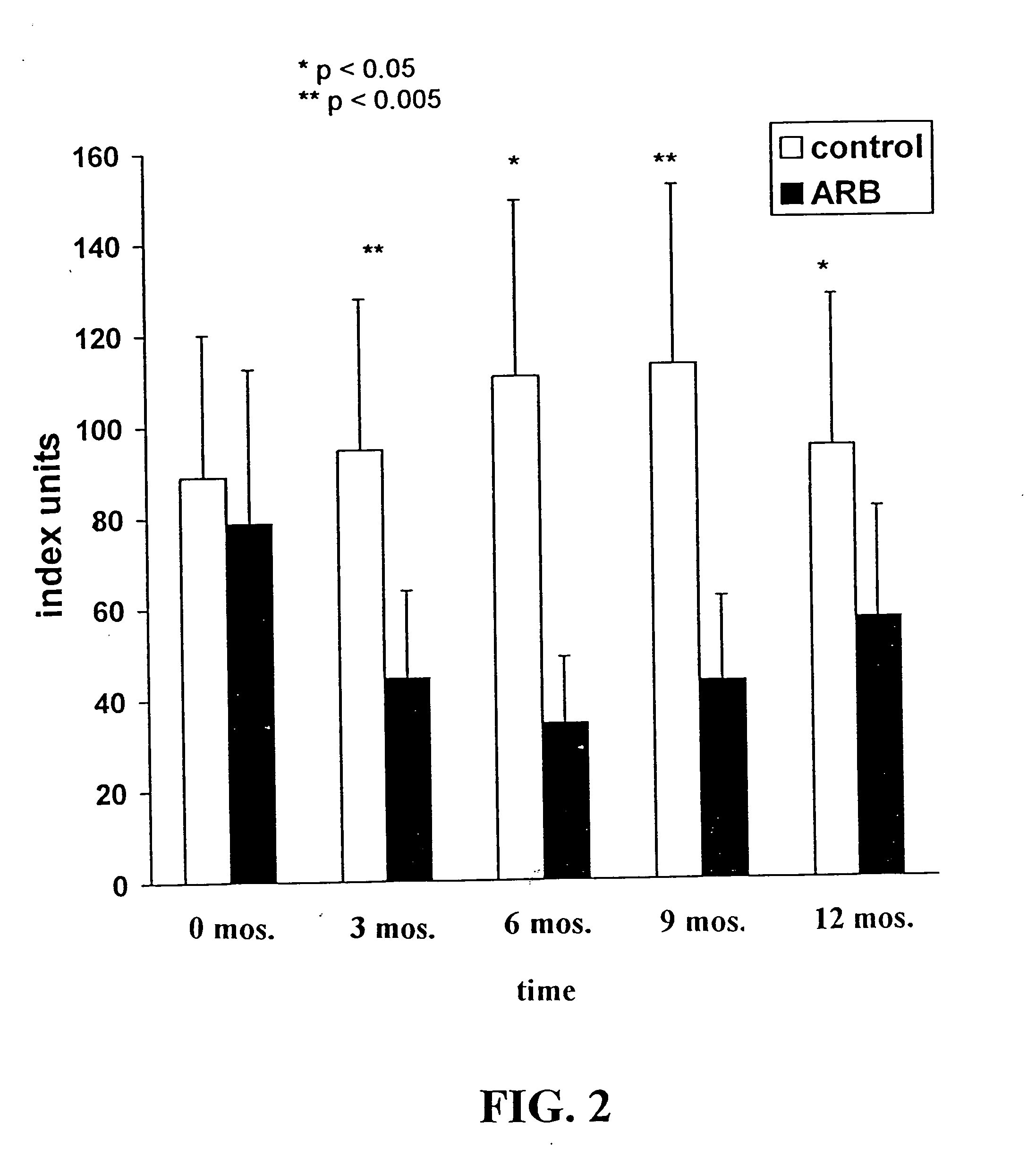Method of decreasing inflammation in kidney transplantion using angiotensin receptor blockers
an angiotensin receptor blocker and kidney technology, applied in the direction of biocide, immunological disorders, drug compositions, etc., can solve the problems of insufficient data examining the effects of agents, and achieve the effect of suppressing the growth of t cells and being useful and beneficial as a treatmen
- Summary
- Abstract
- Description
- Claims
- Application Information
AI Technical Summary
Benefits of technology
Problems solved by technology
Method used
Image
Examples
example 1
The Study Population
[0075] The study, enrollment process, and protocols described herein were approved by the University of Wisconsin Institutional Review Board. Individuals with evidence of chronic allograft dysfunction have allograft functionality greater than 6 months with serum creatinine≧0.3 mg / dl above discharge creatinine. In the absence of acute rejection, these individuals have obstructive uropathy or urinary tract infection. To be eligible for the study, individuals also had concomitant evidence of elevated blood pressure (>140 / 80) and / or proteinuria (>2+ on dipstick urinalysis or spot urine protein-to-creatinine ratio>1).
[0076] Once identified, study subjects were randomized and treated with either losartan (25-100 mg) as part of their anti-hypertensive regimen or with other types of anti-hypertensive agents, e.g., calcium channel blockers. Agents functioning as AT1R blockers were excluded. Neither group received ACE inhibitors. Study subjects were maintained on their s...
example 2
Detection of Urinary Hydrogen Peroxide (H2O2)
[0078] The Amplex Red Hydrogen Peroxide / Peroxidase Assay Kit (Molecular Probes, Eugene, Ore.) was used according to the manufacturer's instructions to measure H2O2. Briefly, urine samples were centrifuged at 1000 rpm for 10 minutes at room temperature. Serial 50 μl dilutions of H2O2 (standard curve), and urine supernatants were placed into individual wells of a 96-well microplate. A 50 μl volume of the Amplex Red reagent / HRP solution was then added to each microplate well containing the standards and samples. The plate was incubated at room temperature for 30 minutes, protected from light. A microplate reader with fluorescence emission detection at 590 nm was used to measure H2O2 levels. H2O2 concentrations were read from the standard curve.
example 3
Peripheral Blood Lymphocyte (PBL) Harvest From CAN Patients
[0079] Eight to nine milliliters of whole blood taken at each time point from each individual were incubated at room temperature in 40 ml ACK lysis buffer (150 mM NH4Cl, 10 mM KHCO3, 0.1 mM Na2EDTA, pH 7.3) for 10 minutes to lyse red blood cells. Samples were then centrifuged at 1000 rpm. The supernatant was discarded. Cells were resuspended in 10 ml complete RPMI media (RPMI-1640, BioWhitaker, Walkersville, Md.) supplemented with FCS (Sigma Aldrich, St. Louis, Mo.); 2 mM L-glutamine (BioWhitaker); 50 μM 2-β-mercaptoethanol (Sigma Aldrich); 100 U / ml penicillin; and 100 μg / ml streptomycin sulfate (Sigma Aldrich).
[0080] Twenty μl of this sample was removed for cell enumeration. Forty ml of complete RPMI media was then added to the remaining sample and this was centrifuged at 1000 rpm for 10 minutes. The resulting PBL pellet was resuspended in complete RPMI media at a concentration of 1.5×106 cells per ml.
PUM
| Property | Measurement | Unit |
|---|---|---|
| volume | aaaaa | aaaaa |
| pH | aaaaa | aaaaa |
| blood pressure | aaaaa | aaaaa |
Abstract
Description
Claims
Application Information
 Login to View More
Login to View More - R&D
- Intellectual Property
- Life Sciences
- Materials
- Tech Scout
- Unparalleled Data Quality
- Higher Quality Content
- 60% Fewer Hallucinations
Browse by: Latest US Patents, China's latest patents, Technical Efficacy Thesaurus, Application Domain, Technology Topic, Popular Technical Reports.
© 2025 PatSnap. All rights reserved.Legal|Privacy policy|Modern Slavery Act Transparency Statement|Sitemap|About US| Contact US: help@patsnap.com



